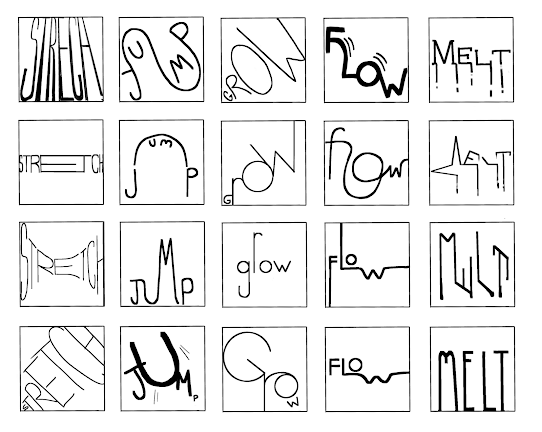Typography | TASK 1 : Exercises
22.4.25 - 20.5.25 | Week 1 - 5
Haley Alexandra Gray | 0369029 | Bachelors of Design in Creative Media
Typography GCD60104
Task 1 | Exercises
Lecture Material
- Typography Timeline :
- Modern letters can be derived from the Phoenician alphabet.
- Greeks changed direction of writing, where they developed a tsyle of writing called boustrophedon, meaning the lines of text read alternately from right to left, vice versa after the line, changing the direction of reading and orientation of letterforms. Conventional methods at the time was writing from right to left.
- Etruscan carvers working on marble painted letterforms before inscribing them. Certain qualities of their strokes influenced the letterform evolution.
 |
| Fig.1 Progression from Phoenician to Greek to Roman letters | from lecture Typo_1_Development |
Handscript from 3rd - 10th century CE
Blackletter to Gutenberg's type
Text Type Classifications
- 1450 - Blackletter
- 1475 - Oldstyle
- 1500 - Italic
- 1550 - Script
- 1750 - Transitional
- 1775 - Modern
- 1825 - Serifs
- 1900 - Sans Serifs
- 1990 - Serif / Sans Serif
 |
| Fig. 2 Anatomy of a Typeface | from lecture Typo_3_Text Part 1 |
 |
| Fig. 4 Line space vs leading, Nick Sherman |
Instructions
Task 1 | Part 1

 |
| Fig. 7 Jump References (22/4/25) |
 |
| Fig. 10 Flow References (22/4/25) |
Preliminary sketches
 |
| Fig. 11 Preliminary sketches before Feedback on paper (22/4/25) |
 |
| Fig. 13 Preliminary sketches after Feedback (29/4/25) |
Digitisation
 |
| Fig. 14 Digitisation before Feedback (1/5/25) |

Final Choices -
GIF Process -
 |
| Fig. 20 Animation process - Duplicating and editing frame per frame (14/5/25) |
 |
| Fig. 21 All of my layers in Adobe Illustrator (14/5/25 |
 |
| Fig. 22 Animation (15/5/25) |
Final Outcome
The final outcome for this part would be 4 words designed to their meaning, as well as an animated GIF pertaining to their meaning.| Fig. 24 Kerning & Tracking 1/4 (17/5/25) |
| |
| Fig. 25 Kerning & Tracking 2.4 (18/5/25) |
4/4 : INDIVIDUAL DESIGN TASK
Layout Exploration -
 |
| Fig. 29 8 Layout Explorations (19/5/25) |
I realised that this text might not have a subtext that goes under the title, I just assumed it would be that case, so I made the changes to add that piece of text back into the paragraph.
Final Outcome
Font/s: ITC New Baskerville STD Bold
Type Size/s: 39 pt
Leading: 36 pt
Paragraph spacing: 0
Body :
Font/s: ITC New Baskerville STD Regular
Type Size/s: 10 pt
Leading: 12 pt
Paragraph spacing: 12 pt
Characters per-line: 61
Alignment: Left-Align
Margins: Top = 21 mm, Bottom = 22 mm, Left = 0 mm, Right = 14 mm
Columns: 2
Gutter: 0 mm, (13 mm between original gutter and manual guide line)
Feedback
Week 1 (22/4/25)
Week 2 (29/4/25)
________
Reflection
Experience :
During these first few classes and tasks, I have developed more awareness to what Typography actually is, and how meticulous you have to be to have a good, accurate design. Having not really known the depth of Typography, I went into this module thinking it would be something easy and light. I was mistaken.. However, it was interesting to learn more about lettering, history of fonts, all the terminologies, and what/what not to do, which I'm sure will benefit me later on. As well as that, the exercises were enjoyable to me, trying to create a new design to interpret words, and the formatting exercise - it made a good introduction and starting point for me to Typography, and I am happy with the outcome of these classes so far. I have also gained more experience with using Adobe Illustrator and InDesign.
Observations :
I have observed that Typography is more than just text-based designs and such, it is way more than that, and it has never occured to me before but it is definitely an art form. Like designing other things, planning and preliminary designs are crucial to getting to where you want to be in Typography, and using the various softwares needed require a lot of time to familiarise yourself with. I have also noticed that even if we think our designs feel original, there is a chance someone around you has thought of it as well, so there has to be extra effort and creativity when coming up with new ideas to use in our assignments, as well as outside the classroom. That being said, Typography is quite time consuming, and I am going to have to be careful about time management, however after being in Mr Vinod's class in semester 1 for DP (who is the head of the Typography module I think), I am familiar with how to get my tasks in order and the requirements we have to do each week generally on time.
Findings :
Overall, I have found Typography to be challenging yet rewarding and interesting in it's own way. I have found out more on the origin of fonts and letters, as well as gaining Adobe Illustrator and InDesign skills to carry out the tasks. The work itself taught me alot about how certain fonts and designs can change the appearance / effect of the word drastically, and to choose the appropriate one takes a lot of planning and exploration. In the future, I believe I have to be more open minded about changes I have to make in my designs, as I find myself reluctant to change, leading me to put out less ideas/explorations.
References
Meyer. T. D. (2016, February 1). When The Ice Melts [Photography]. Facebook. Online URL :
Sable. J. (2018. July 27). Alishan Forest Railway / Housework [Digital Album Cover]. Bandcamp. Online
























Comments
Post a Comment